From sea anchors, drogues, and trysails to forereaching and heaving to, tactics and gear for surviving a storm at sea vary greatly. During a high-latitude circumnavigation, Evans Starzinger and Beth Leonard, aboard their 47-foot Van de Stadt sloop, had several opportunities to test heavy-weather sailing tactics. The couples main storm gear was a Galerider sea drogue, made by sailmakers Hathaway, Reiser and Raymond, is a webbing bowl with a wire hoop. Deploying the drogue involved a bridle of strong nylon lines connected to the Galerider rode via an oversized galvanized swivel. Starzinger and Leonard used the Galerider when running before the wind in gale-force conditions. The drogue helped slow the boat,
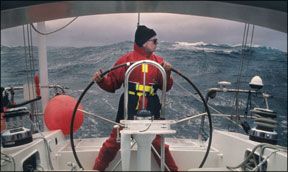
Photos by Beth Leonard and Evans Starzinger
kept it from surfing down the face of a wave, and provided directional stability, which allowed their autopilot to maintain control. Drogues and other storm-survival gear and tactics are particularly necessary for short-handed crews and boats that tend to surf in heavy weather. Other storm gear for sailboats that Practical Sailor looked at included the Jordan Series drogue and the Seabrake drogue.
****
Heavy-weather techniques remain one of the most contentious areas of seamanship, in large part because so few people have any real experience with any of the options, and only a handful have tried a variety of options on different boats in different conditions.
From sea anchors, drogues, and trysails to forereaching and heaving to, tactics and gear for surviving a storm at sea abound.
In the Feb. 1, 2005 issue of Practical Sailor, testers looked at parachute-style sea anchors from well-known makers Para-Tech (the Sea Anchor) and Fiorentino (Para-Anchor). Both offer high-quality storm gear, but the 2005 tests favored the Para-Anchor because of its more rugged construction.
Veteran cruisers Lin and Larry Pardey, in the third edition of the “Storm Tactics Handbook,” tout heaving-to as their preferred heavy-weather tactic. But the book also explores other veteran sailors survival methods, how to decide what will work for you, and how to prepare for storms at sea.
In the course of a high-latitude circumnavigation aboard Hawk, a 47-foot Van de Stadt Samoa, Practical Sailor contributors Beth Leonard and Evans Starzinger found their primary heavy-weather tactics to be forereaching if their destination was towindward and running free or with the Galerider drogue if their destination was downwind. Their experiences with the Galerider can help you decide whether it would be a useful option for your boat in heavy weather.
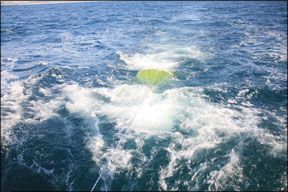
DROGUE
A drogue is anything towed from the stern of the boat to slow it down without stopping it completely. It acts like rear-wheel brakes on a runaway truck going down a steep hill. In breaking-wave conditions, a drogue keeps boatspeed manageable as the boat tries to accelerate down a wave face, and its pull keeps the stern of the boat toward an oncoming wave, helping prevent a broach where the boat could turn sideways and be dangerously swept, possibly capsized, by a breaking wave.
Traditionally, drogues consisted of long warps alone or with tires, chain, sails, and even anchors attached. Today, cruisers can purchase a variety of commercially manufactured drogues including the Delta drogue, Galerider, and Jordan Series drogue. These have the advantage of being designed to exert a consistent amount of resistance while moving through the water smoothly, without inverting, spinning, or slewing off in one direction or another.
Drogues fall into two categories: low-pull or speed-limiting, which check the boats speed and keep it from surfing while maintaining momentum and steerageway; and medium-pull, which are designed to slow the boat to a knot or two and hold the stern steadily into the wind and waves. The Galerider, Delta, and Australian-made Seabrake are examples of speed-limiting drogues, and the Jordan Series and various small parachute-type drogues (as opposed to parachute sea anchors, which are meant to be deployed off the bow and stop the boat completely) are considered medium-pull drogues.
GALERIDER ABOARD HAWK
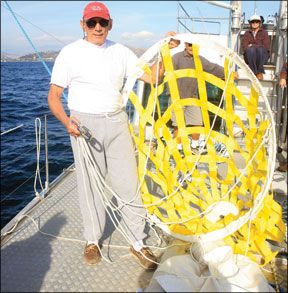
Hawks Galerider-made by sailmakers Hathaway, Reiser, and Raymond-consists of a webbing bowl about 48 inches in length attached to a circular wire rim 42 inches in diameter and designed for a boat with a displacement of 30,000 to 55,000 pounds. The Galerider design allows water to flow through it, which lets the boat keep moving at a moderate speed while, in theory, creating sufficient resistance to keep it from surfing. A bridle of strong nylon lines connects with the rode via an oversized stainless-steel swivel. The whole thing stows neatly into a flat bag half the diameter of the rim.
Hawk is a 47-foot, aluminum, fractional-rigged sloop with a 30,000-pound displacement, fin keel, and a spade rudder. When running toward our destination in heavy weather before large seas that are not breaking, we believe we are safest maintaining boatspeed so long as the boat remains in good control and responsive to the helm. Our forward speed stabilizes the boat in the waves while lessening the impact of the waves on the hull and minimizing the chances of the boat being pooped or swept by a wave.
Hawks modern underbody and moderate displacement mean that in gale- or storm-force winds, she will spend a good deal of her time surfing, regularly hitting speeds of 12 or 13 knots. This tends to happen at around 40 knots of wind in 10- to 15-foot seas, and slightly less wind in bigger seas.
In those conditions, our autopilot does not respond quickly enough to maintain complete control if the balance between wind and waves suddenly shifts. And with only two of us for crew, keeping us both operational is critical to our safety and the safety of the boat, which means not spending hours at the helm in near-freezing temperatures, hand-steering, unless it is absolutely necessary. The Galerider drogue stops the boat from surfing and provides directional stability, allowing the autopilot to maintain control.
Rode Anatomy
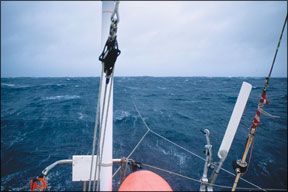
We know it is time to deploy the drogue when Hawk begins consistently surfing at over 10 knots, or when the autopilot doesn’t react quickly enough and our stern gets slewed around by a wave in a near-broach. Up to about 50 knots true, we use a storm jib to help stabilize the boat, keep her tracking downwind and minimize rolling. Once the drogue is deployed, we can feel the storm jib pulling against it and the damped surge when a wave picks Hawk up and tries to sweep her away. The boat feels like shes held in place by a spring that stretches when a wave grabs her but stops her before she can get surfing.
In theory, speed-limiting drogues like the Galerider should be deployed two waves back and in the opposite part of the wave to the boat. (See illustration, page 27.) That is, when the boat is on a wave face, the drogue should be in the back of the second wave behind the boat. This keeps the drogue from being jerked out of the face of the wave as the boat accelerates toward the trough. In reality, this is a useful target but impossible to exactly execute. Its incredibly difficult to tell where the drogue is if it is more than one wave behind you, and wave lengths vary dramatically through even a one-hour period in a storm.
The first time we used the Galerider, we deployed it on 300 feet of nylon, double-braid line without a bridle. We found this a very unstable rode length. In the periods of the largest waves, the drogue ended up in the wave directly behind us, and several times we pulled it right out of the wave face. In this situation, we would like to have added more rode, but we couldnt easily add a second line with the rode under load. Most people who have used drogues find that the rode length deployed initially tends to be the rode length carried throughout the storm.
The second time we used the Galerider, in a Southern Ocean storm when we were approaching Tasmania, we deployed it on 600 feet of rode and used a bridle. After further experimentation, all in long-period Southern Ocean waves, we have found two “sweet spots” for Hawk, at about 100 feet with the drogue in the same wave as the boat and at 500 to 600 feet, with the drogue more than a wave length behind the boat.
Our 600-foot rode consists of two of our 300-foot warps tied together using an anchor bend with the tails whipped back to the rode to prevent the knot from slipping. The bridle consists of a 75-foot retired, low-stretch Spectra jib sheet, which we attach 70 feet from the bitter end of the rode using an icicle hitch. Again, we whip the tails to secure the knot. (You can find illustrated instructions on tying this and other knots mentioned in this article at www.bethandevans.com, at the bottom of the “Articles page.”) We prepare the rode and the bridle before passage, so the drogue is ready to be deployed when and if needed. The bridle helps to keep the boat tracking dead downwind, and we much prefer it to towing the Galerider off the quarter.

There is much debate on how much load the drogue is actually under in storm conditions, and, therefore, on how strong attachment points need to be. We have retrieved our Galerider when winds have dropped to gale force using our primary winches and found we couldnt turn the winch using low speed and all our strength when the drogue was fully loaded. That means in gale (not storm) conditions, our Galerider generates steady state forces in excess of 3,500 pounds, a number consistent with the elongation we have measured in the rode when under load.
To withstand these forces requires very strong attachment points with totally fair and chafe-free leads. We run the rode directly to our primary winches through over-sized Lewmar or Harken snatch blocks shackled to lifting eyes welded into the aft end of the toerail. The rode comes in contact only with the winch and the snatch block sheave on each side of the boat. Using this method, we have never had any chafe on the rode when trailing a drogue.
Deploying The Drogue
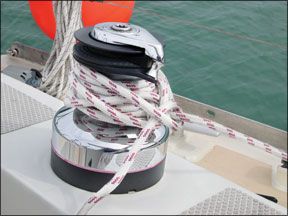
When leaving on passage, we stow the Galerider and the warps (kept in mesh bags) so that everything will be accessible even if we are seasick. To deploy the Galerider, we bring everything up on deck. Then we lead the bitter end of the rode and of the bridle line through the large snatch blocks attached at the aft end of the toerail, bringing the end of the rode through on one side and the end of the bridle through on the other.
We lead the lines to our primary winches, pull in 30 feet or so of extra line, and then lock the line off in the self-tailer on the winch. We then coil the rest of the rode down on the helmsmans seat in a large figure eight so that the line will run free once the Galerider is deployed. When we reach the thimble spliced into the drogue end of the rode, we shackle this to the swivel on the Galerider drogue, mouse the shackle with a wire tie, and double check that everything is secure.
One of us takes the position by the winch, holding the bridle line, and the other shakes out the Galerider, holds it open against the wind, and tosses it in the water. The person deploying the drogue needs to stand clear as the line whips off the helmsmans seat.
When the drogue bites, Hawk checks for an instant and then settles down into a relaxed 6 or 7 knots of boatspeed. We adjust the bridle line until the rode attachment point is straight behind the boat, and then secure both the bridle line and the rode by cleating them off or using a tugboat hitch.
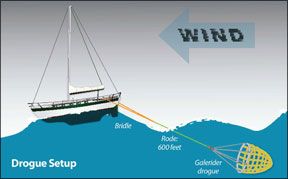
Overall, the Galerider does not decrease our speed by that much-about two to three knots, down from 8 to 10 knots. What the Galerider really does is stop the boat from surfing, reducing her top speed from 12 knots and more down to 8. That allows the autopilot to remain in control of the boat and ensures that we do not broach.
RETRIEVING THE DROGUE
Retrieving the Galerider takes a good amount of sustained physical effort. Even with our oversized primary winches, we have to wait for some slack to develop in the line, then winch in as quickly as possible before the line goes taut again. Using our primary winch and working in shifts of 20 to 30 minutes each, it has taken us over two hours to winch in a 300-foot rode, although in theory this should be possible in just over an hour. With 600 feet of rode out, weve found its much easier to use the anchor windlass to retrieve the first half, up to the point where the two lines are joined by the anchor bend.
To do this, we set up a series of snatch blocks to lead the rode up the sidedeck to the windlass. We can sit on the foredeck to make sure were secure, and tail the rode with our hands while using one foot to work the windlass button. It takes about 20 minutes to retrieve the first 300 feet of rode using the windlass and an hour and a half to get in the second 300 feet using the primary winch.
When the Galerider comes to the stern, we use a boathook to grab the rim of the drogue and pull it in.
GALERIDER FAILURE
The first Galerider we used broke the first time we deployed it, after about 12 hours of use. The 18,000-pound test, 1 x 7 stainless-steel wire rim broke clean through. The rim was swaged, but the swage was still intact when we retrieved the drogue. The webbing and lines also were intact.
After it broke, it was no longer as stable, slewing around from side to side and yanking hard at the stern.
We contacted the Galerider manufacturer, sailmakers Hathaway, Reiser, and Raymond, and they replaced the Galerider without cost. We returned the broken Galerider to the company for testing to determine what went wrong. We have not had a problem with the replacement Galerider.
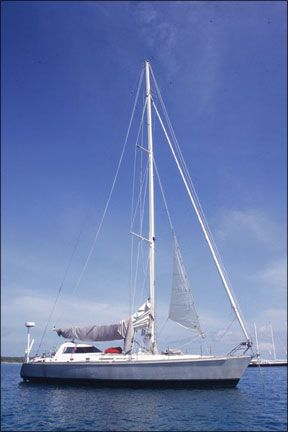
According to Skip Raymond, co-inventor the Galerider, the company sent the wire to the wire manufacturer for testing and analysis. As Raymond recalls, the manufacturer confirmed that there was no corrosion and that the wire had not been cut. To date, there is no definitive explanation for the failure.
Raymond stated that out of more than 1,000 Galeriders produced, the sailmakers have had only three other reported failures. These were attributed to poor storage methods (a wet locker, possibly) that led to electrolytic decay. As previous Practical Sailor articles have shown (“Keep a Close Watch on Marine Metals,” February 2007), stainless steel is hardly immune to corrosion. In Practical Sailors opinion, an improvement would allow for better inspection of the wire and Nicro Press sleeve, but this presents other technical challenges. Storing the Galerider in the opened position will also relieve strain that might, over time, affect the integrity of the wire.
CONCLUSIONS
Prudent voyage planning combined with improved weather forecasting means that very few cruisers ever have to deal with a serious storm.
In 100,000 nautical miles of offshore sailing, including more than 12,000 nautical miles in the Southern Ocean, we have experienced sustained storm-force winds (48 knots and over) in just two storms for less than 36 hours total. The little heavy weather most cruisers encounter will be gale force, with a few gusts to 45 knots or so.
Any well-found boat managed with a bit of knowledge will be able to handle these conditions. If going upwind, heaving-to or forereaching will be most comfortable for the crew while minimizing leeway. If the course lies downwind, many experienced cruisers prefer to keep going, running ahead of the wind and seas, either free orwith a drogue like the Galerider.
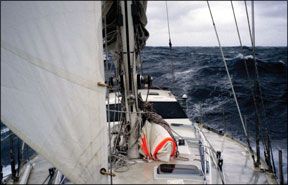
Our experiences have left us with several conclusions that may help others decide whether or not to choose a Galerider drogue as heavy-weather gear aboard their boat.
If your boat will surf in large waves with 25 or 30 knots of wind on the quarter, then the Galerider will help to control the boat in stronger winds. A boat that will not surf in these conditions (and many cruising boats will not) probably will be fine with just a warp and no drogue. That said, in large waves such as those found in the Southern Ocean, even boats that tend to resist surfing can benefit from a speed-limiting drogue.
To keep steerageway and good control, most boats will want to run at 4 to 8 knots. We find Hawk to be most comfortable at the higher end of this range. Smaller or more traditional boats will probably be more comfortable at slower speeds. If the boat is wallowing and losing steerageway in the troughs, youre going too slow. If its surfing more than occasionally, youre going too fast, and a warp or speed-limiting drogue will help to maintain steering control.
The Galerider, like most drogues, requires sufficiently strong, chafe-free attachment points. It can be difficult to get a chafe-free lead to a stern cleat, and some may not be strong enough for the loads. On most boats, through-bolting a padeye with a large, stainless steel backing plate near each stern quarter to which an oversized snatch block can be attached and orienting it so the line can pass cleanly to the primary winch will create a strong enough attachment point. Have this set up before leaving on passage.
In any storm situation, don’t continue with a tactic if things don’t feel “right.” Weve always been able to tell when the boats not coping. Solid-water hits that make the whole boat shake or the on-the-edge feeling where the helm goes soft in your hand in the crest of a wave are both indications that you need to try some other storm tactic.
Inspect the Galerider-or any other sea anchor or drogue you use-regularly and with the same scrutiny as you do your rigging, even if it has been sitting in the bag. Practical Sailor does not encourage buying or using an old Galerider without verifying its integrity, particularly the stainless hoop and swage and the fabric.
Weve never been in conditions where we felt unsafe using the Galerider. It has proven to be the most used and most valuable piece of heavy-weather equipment we carry, and it continues to be our tactic of choice in gale- to storm-force winds.
Regular
Practical Sailor contributors, Beth Leonard and Evans Starzinger have sailed more than 100,000 miles and have completed two circumnavigations.




































